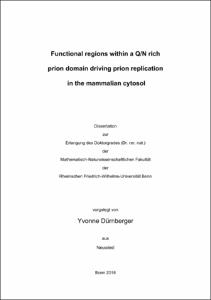Dürnberger, Yvonne: Functional regions within a Q/N rich prion domain driving prion replication in the mammalian cytosol. - Bonn, 2017. - Dissertation, Rheinische Friedrich-Wilhelms-Universität Bonn.
Online-Ausgabe in bonndoc: https://nbn-resolving.org/urn:nbn:de:hbz:5n-47283
Online-Ausgabe in bonndoc: https://nbn-resolving.org/urn:nbn:de:hbz:5n-47283
@phdthesis{handle:20.500.11811/7188,
urn: https://nbn-resolving.org/urn:nbn:de:hbz:5n-47283,
author = {{Yvonne Dürnberger}},
title = {Functional regions within a Q/N rich prion domain driving prion replication in the mammalian cytosol},
school = {Rheinische Friedrich-Wilhelms-Universität Bonn},
year = 2017,
month = may,
note = {Prions are proteinaceous infectious agents that replicate by recruiting and converting homotypic soluble proteins into growing aggregates. Prions in mammals cause transmissible spongiform encephalopthies and are composed of membrane-bound PrP. In addition to prions in mammals, infectious protein aggregates were also identified in lower eukaryotes. Prion domains of lower eukaryotes are often enriched in glutamine (Q) and asparagine (N) residues and are usually located in unstructured regions. Interestingly, approximately one percent of human protein-coding genes contain Q/N rich prion-like domains. Until recently, it was unclear if prion replication is possible in the mammalian cytosol. By expressing the prion domain of Saccharomyces cerevisiae Sup35 in mouse neuroblastoma cells, our group could already show that Q/N rich prions can replicate in the mammalian cytosol. Yet, which regions within the Q/N rich prion domain of Sup35 specifically drive prion induction, propagation and inheritance in mammalian cells was so far unclear. Therefore, the aim of this study was to identify the essential regions that are required for the individual steps of prion replication in the mammalian cytosol. Surprisingly, we found that the aminoterminal region essential for prion activity in yeast, was dispensable for prion replication in the mammalian cytosol and even helped to retain the protein in its soluble state. Instead, we identified a carboxyterminal region with a lower Q/N content as the crucial region for prion replication in mammalian cells, a region that was shown not to influence prion formation in yeast. Interestingly, we found that in mammalian cells all prion activity was governed by only one distinct region, whereas in yeast, prion replication processes were depending on separate elements. Combined, these findings indicate that prion domains active in mammalian cells differ from the ones active in yeast, and suggest that studies on prionogenic behavior of prion or prion-like proteins should be undertaken in the correct environment. Our data provides a more detailed insight into the requirements for cytosolic prion replication in the mammalian cytosol, and will help to better predict proteins with prion-like properties that might be the cause for diseases of so far unknown etiology in mammals.},
url = {https://hdl.handle.net/20.500.11811/7188}
}
urn: https://nbn-resolving.org/urn:nbn:de:hbz:5n-47283,
author = {{Yvonne Dürnberger}},
title = {Functional regions within a Q/N rich prion domain driving prion replication in the mammalian cytosol},
school = {Rheinische Friedrich-Wilhelms-Universität Bonn},
year = 2017,
month = may,
note = {Prions are proteinaceous infectious agents that replicate by recruiting and converting homotypic soluble proteins into growing aggregates. Prions in mammals cause transmissible spongiform encephalopthies and are composed of membrane-bound PrP. In addition to prions in mammals, infectious protein aggregates were also identified in lower eukaryotes. Prion domains of lower eukaryotes are often enriched in glutamine (Q) and asparagine (N) residues and are usually located in unstructured regions. Interestingly, approximately one percent of human protein-coding genes contain Q/N rich prion-like domains. Until recently, it was unclear if prion replication is possible in the mammalian cytosol. By expressing the prion domain of Saccharomyces cerevisiae Sup35 in mouse neuroblastoma cells, our group could already show that Q/N rich prions can replicate in the mammalian cytosol. Yet, which regions within the Q/N rich prion domain of Sup35 specifically drive prion induction, propagation and inheritance in mammalian cells was so far unclear. Therefore, the aim of this study was to identify the essential regions that are required for the individual steps of prion replication in the mammalian cytosol. Surprisingly, we found that the aminoterminal region essential for prion activity in yeast, was dispensable for prion replication in the mammalian cytosol and even helped to retain the protein in its soluble state. Instead, we identified a carboxyterminal region with a lower Q/N content as the crucial region for prion replication in mammalian cells, a region that was shown not to influence prion formation in yeast. Interestingly, we found that in mammalian cells all prion activity was governed by only one distinct region, whereas in yeast, prion replication processes were depending on separate elements. Combined, these findings indicate that prion domains active in mammalian cells differ from the ones active in yeast, and suggest that studies on prionogenic behavior of prion or prion-like proteins should be undertaken in the correct environment. Our data provides a more detailed insight into the requirements for cytosolic prion replication in the mammalian cytosol, and will help to better predict proteins with prion-like properties that might be the cause for diseases of so far unknown etiology in mammals.},
url = {https://hdl.handle.net/20.500.11811/7188}
}






